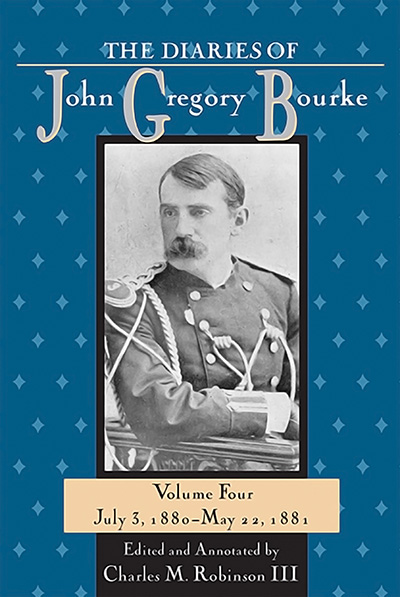
May, 2009
Published
592
Pages
31 b&w photos. 2 maps. App. Notes. Bib. Index.
Features
About Robinson III's The Diaries of John Gregory Bourke Volume 4
John Gregory Bourke kept a monumental set of diaries beginning as a young cavalry lieutenant in Arizona in 1872, and ending the evening before his death in 1896. As aide-de-camp to Brigadier General George Crook, he had an insider’s view of the early Apache campaigns, the Great Sioux War, the Cheyenne Outbreak, and the Geronimo War. Bourke’s writings reveal much about military life on the western frontier, but he also was a noted ethnologist, writing extensive descriptions of American Indian civilization and illustrating his diaries with sketches and photographs.
Previously, researchers could consult only a small part of Bourke’s diary material in various publications, or else take a research trip to the archive and microfilm housed at West Point. Now, for the first time, the 124 manuscript volumes of the Bourke diaries are being compiled, edited, and annotated by Charles M. Robinson III, in a planned set of eight books easily accessible to the modern researcher.
Volume 4 chronicles the political and managerial affairs in Crook’s Department of the Platte. A large portion centers on the continuing controversy concerning the forced relocation of the Ponca Indians from their ancient homeland along the Dakota-Nebraska line to a new reservation in the Indian Territory. An equally large portion concerns Bourke’s ethnological work under official sanction from the army and the Bureau of Ethnology, work which would make a profound change in his life and his place in history. Aside from a summary of the entire Ponca affair in approximately two pages, virtually none of this material appears in Bourke’s classic On the Border with Crook.
Bourke’s staff duties bring him into contact with many prominent individuals. He is particularly unimpressed with the commander of the army, General W.T. Sherman, who, he wrote, “is largely made up of the demagogue and will not survive in history.” He also is harsh on President Rutherford B. Hayes, now finishing out his term.
This volume contains detailed descriptions of several tours, including those to Yellowstone National Park and the Santa Fe regions. Bourke reveals the profound changes that have overtaken the Indians in only a few years of settlement on reservations. At the new Spotted Tail, or Rosebud, Agency, he found a conference in progress, where the Milwaukee & St. Paul Railroad was attempting to buy right of way across the reservation. The leaders Spotted Tail and Red Cloud had wasted little time in determining what was valuable to the whites—they astutely bargained for a high price.
Extensively annotated and with a biographical appendix on Indians, civilians, and military personnel named in the diaries, this book will appeal to western and military historians, students of American Indian life and culture, and to anyone interested in the development of the American West.
About the Editor
CHARLES M. ROBINSON III received his bachelor’s degree from St. Edward’s University and master’s from the University of Texas-Pan American, and was a history instructor at South Texas Community College. He wrote more than twelve books, including Bad Hand: A Biography of General Ranald S. Mackenzie (T.R. Fehrenbach Award) and The Court Martial of Lieutenant Henry Flipper (Spur Award finalist). Robinson appeared on television documentaries for the Public Broadcasting System and the History Channel.
Buy Now
The Diaries of John Gregory Bourke Volume 4: July 3, 1880-May 22, 1881
592 pp. 31 b&w photos. 2 maps. App. Notes. Bib. Index.